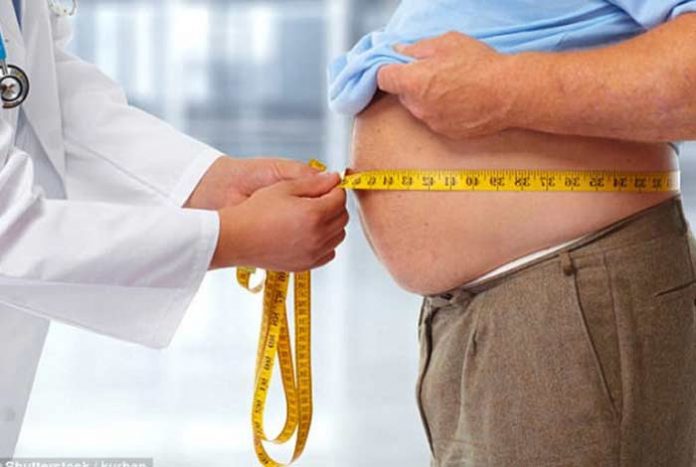
Waistlines across the globe are increasing. In 2016, more than 1.9 billion adults were found to be overweight, out of which, around 650 million were found to be obese. This happens due to accumulation of excessive fat in the body. Obesity is different from being overweight, which simply means weighing too much that it starts affecting your health. When the weight of a person is 10-20 % more than the normal weight defined by standard height/weight chart, it is classified as overweight. When the weight is 20% or higher than the normal weight, it is termed as obesity. This extra weight can come from fat, bone, muscle and/or body water.
There are several methods by which you can determine whether you are overweight or not. Some of these are described below:
Body Mass Index (BMI)
According to WHO, body mass index (BMI) is a term that is used for accurately classifying overweight and obesity. It is defined as the ratio of a person’s weight in kg to the square of his height in meter (kg/m2).
| Classification | BMI (kg/m2) | |
| Principal Cut-Off Points | Additional Cut off Points | |
| Underweight | <18.50 | <18.50 |
| Severe thinness | <16.00 | <16.00 |
| Moderate thinness | 16.0 -16.99 | 16.00-16.99 |
| Mild thinness | 17.00-18.49 | 17.00 – 18.49 |
| Normal Range | 18.50-24.99 | 18.50-22.99 |
| 23.00-24.99 | ||
| Overweight | >=25.00 | >=25.00 |
| Pre-Obese | 25.00- 29.99 | 25.00-27.49 |
| 27.50-29.99 | ||
| Obese | >= 30.00 | >= 30.00 |
| Obese Class I | 30.00 – 34.99 | 30.00-32.49 |
| 32.50-34.99 | ||
| Obese Class II | 35.00 – 39.99 | 35.00- 37.49 |
| 37.50 – 39.99 | ||
| Obese Class III | >= 40.00 | >= 40.00 |
Source: Adapted from WHO 1995, WHO 2000 and WHO 2004
BMI values are independent of age and gender. Different populations have different body proportions and hence, BMI might not correspond to the same degree of fatness in each population.
In the recent years, there has been an increase in the demand for defining different cut-off points for different ethnic groups because of the growing evidence which points towards the relationship between BMI, body fat distribution and percentage of body fat, and ethnicity.
The relationship between BMI and body fatness is well established. However, some variations occur due to gender, race and age. At the same BMI, women tend to have more body fat than men. Athletes, on the other hand, might have a high BMI not because of body fatness, but increased muscularity. It should be noted that BMI is not a direct measure of body fatness as it is calculated by using a person’s weight, which includes both fat and muscles.

Waist-to-Hip Ratio
Waist-hip ratio or waist-to-hip ratio is obtained by dividing the circumference of waist by that of hips. It is being used as an indicator of health and fertility. There are different optimal values for males and females.
| DGSP | WHO | NIDDK | ||||
| Women | Men | Women | Men | Women | Men | |
| Under Weight | ? | ? | ? | ? | ? | ? |
| Normal Weight | <0.80 | <0.90 | ? | ? | ? | ? |
| Over Weight | 0.80-0.84 | 0.90-0.99 | ? | ? | ? | ? |
| Obesity | >0.85 | >1.00 | >0.85 | >0.90 | >0.80 | >1.00 |
Table showing waist to hip ratio for males and females, according to DGSP, WHO and NIDDK.
DGSP: Dt. Gesellschaft für Sportmedizin und Prävention
WHO: World Health Organization
NIDDK: National Institute of Diabetes, Digestive and Kidney Diseases

Bio-Electrical Impedance Analysis
Bio-Electrical impedance analysis (BIA) is a method that determines the level of fat in the body with respect to body mass. It indicates what percentage of the body weight is made up of fat. A normal body-fat balance is an indication of good health, whereas excess fat with respect to lean body mass increases the risk of developing cardiovascular diseases and diabetes. It is known to give better results than BMI.
Unlike BMI, the BIA test requires specialized equipment. Minor electrical currents are sent throughout the patient’s body by placing electrodes on the patient’s right hand and foot. It provides an estimate of body water, from which the body fat can be calculated

Calipers
Body fat and fat-free mass are calculated using calipers. The thickness of a fold of skin and its underlying layer of fat is measured by using skin-fold calipers. Total amount of fat in the body is determined by taking measurements at key parts of the body. Ideal caliper measurements are expected to remain under 10 mm.
This test can be done at home if you have the calipers. To determine the fat percentage, an equation further used.

DEXA Scan
DEXA (dual energy X-ray absorptiometry) scan is used to measure body fat and muscle mass, which gives the body composition. Visceral and subcutaneous fat are highlighted by this scan.
DEXA scans are expensive and provide a more extensive report about exactly where the fat is stored in the body. Visceral fat is stored around internal organs like heart, kidney, liver and pancreas, and can cause high blood pressure and diabetes. Individuals, who have healthy BMIs can also have dangerously high levels of visceral fat. In such cases, DEXA scan is used to determine your risk of developing associated chronic diseases.
The scans are quick and painless, and requires you to lie on your back and then being X-rayed. DEXA scans target the 3 major areas of the body, viz., arms, legs and trunk, which gives an idea where the fat is deposited.

Bod Pod
The Bod Pod (Air Displacement Plethysmograph) is an alternative to DEXA scan that help measure body composition.
Bod Pod uses a highly accurate technique – air displacement plethysmography –for determining the areas of fat deposition. Clients are made to sit in an enclosed chamber for a few minutes, and the volume of air displaced by him is determined, which is further used to calculate body fat percentage. It delivers similar results as that of DEXA scans.
Excessive weight results from ingesting more calories than what is required. For every person, the balance between calories-in and calories-out differs. Some of the factors that might increase your chance of getting overweight are:
- Hereditary
- Overeating
- Physical inactivity
- Consuming high fat foods
- Diseases like hypothyroidism, polycystic ovarian disorder and prolactinoma
Being overweight can increase your chances of getting cardiovascular diseases, diabetes, arthritis, stroke and some forms of cancer.











